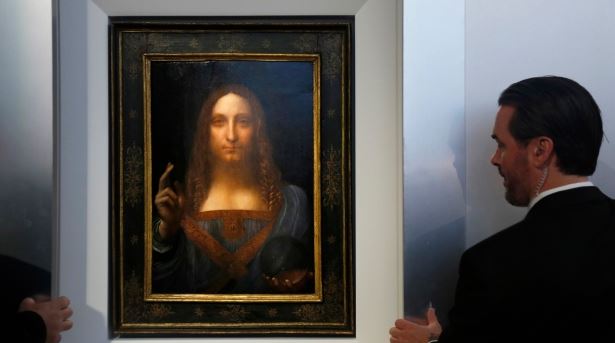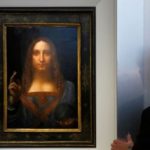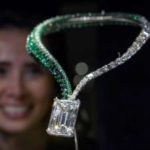Salvator Mundi, the long-lost Leonardo da Vinci painting of Jesus Christ commissioned by King Louis XII of France more than 500 years ago, has sold at Christie’s in New York for $400m, not including the auctioneers’ premiums and fees, shattering the world record for any work of art sold at auction.
The sale generated a sustained 20 minutes of tense telephone bidding as the auctioneer Jussi Pylkkanen juggled rival suitors before a packed crowd of excited onlookers in the salesroom. At one point, Pylkkanen remarked: “Historic moment, we’ll wait” as the bidding went back and forth, pausing at just over $200m as it rose to break the auction record.
At one point, a telephone bidder jumped in, pushing the price from $332m to $350m. The bidding then resumed: $353m, $355m. A jump to $370. A jump to 400m. “Thank you all for your bidding,” said Pykklanen. “Four hundred million selling here at Christie’s. The piece is sold.” The saleroom erupted in cheers and applause. The sale places Salvator Mundi as the highest-priced work sold at auction, including Pablo Picasso’s 1955 Women of Algiers (Version O), sold for $179.4m, and Amedeo Modigliani’s 1917-18 Reclining Nude, sold for $170.4m. Record private sales are believed to include $250m for a painting by Paul Cézanne and $300m for a Paul Gauguin.
Previewing the lot last month, Christie’s described the painting of Christ holding a crystal orb in his left hand and raising his right in benediction as “the biggest discovery of the 21st century”. The painting was consigned to Christie’s by Dmitry Rybolovlev, 50, a Russian fertiliser oligarch who has been at the center of of an art-world scandal involving claims that a Paris-based dealer, Yves Bouvier, cheated the collector out of as much as $1bn on sales of 38 artworks, including the Leonardo.
The sale of Salvator Mundi, which was painted around 1500 and presumed lost until early this century, was Rybolovlev’s largest to date. The collector acquired it from Bouvier for $127m, who had in turn acquired it from Sotheby’s in a private sale in 2013 for about $50m less. Bouvier’s mark-up led to Rybolovlev’s criminal complaint in a Monégasque court, alleging a scheme for overcharging him. The case led to the resignation of Monaco’s then justice minister, Philippe Narmino. Rybolovlev’s spokesman Brian Cattell told the Wall Street Journal the family hoped the sale “will finally bring to an end a very painful chapter”.
Before Rybolovlev, Salvator Mundi had been owned by a consortium of dealers including Alexander Parish, who had picked it up for $10,000 at an estate sale in the US in 2005, and had had it restored and authenticated. It was first unveiled to the public at the National Gallery in London in 2011. Alan Wintermute, a senior specialist in old master paintings at Christie’s in London, called it the “holy grail” of old masters. “To see a fully finished, late masterpiece by Leonardo, made at the peak of his genius, appear for sale in 2017 is as close as I’ve come to an art-world miracle,” he told the Guardian last month. Despite the excitement over the sale of the only Leonardo in private hands – queues of people had formed around Rockefeller Center in New York to see the canvas – many in the art world had wondered if the piece would find a buyer. The identity of the buyer was not immediately known, although western religious iconography is not typically sought by wealthy collectors or institutions in either the Middle East or China, two regions currently driving blockbuster art sales.
In the days leading up the sale, Christie’s produced a video of celebrities viewing the work, among them Leonardo DiCaprio and Patti Smith. In total, Christie’s said, 27,000 people had seen the work on a pre-sale tour with stops in Hong Kong, London and San Francisco.
Christie’s had also found placing the work, despite its celebrity, hard to fathom. In the end, the picture was placed in Christie’s postwar and contemporary evening sale, wedged between lots of work by Cy Twombly, John Currin, Keith Haring and Jean-Michel Basquiat. When asked whether Salvator Mundi’s involvement in the Rybolovlev-Bouvier case might overshadow its sale, Christie’s postwar and contemporary chairman, Loic Gouzer, who secured the work with a $100m guarantee, said: “We cannot comment about sellers, but it has every passport, every visa.”
At the press conference, Artnews reported, Gouzer spoke of the exceptional rarity of a work by Leonardo. “Finding a new one is rarer than finding a new planet,” he said.
“The work of Leonardo is just as influential to the art that is being created today as it was in the 15th and 16th centuries,” he said. “We felt that offering this painting within the context of our postwar and contemporary evening sale is a testament to the enduring relevance of this picture.”
Source: The Guardian U.K.



